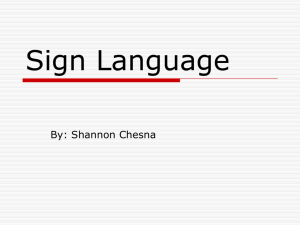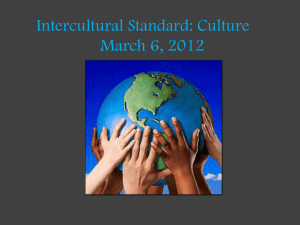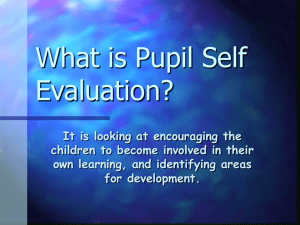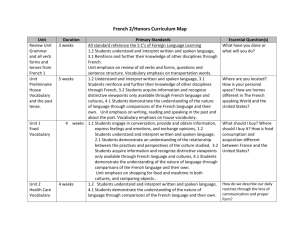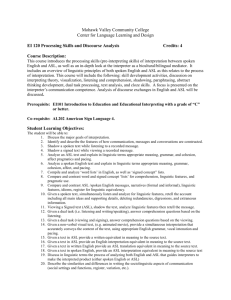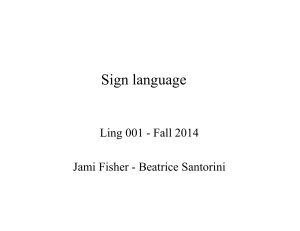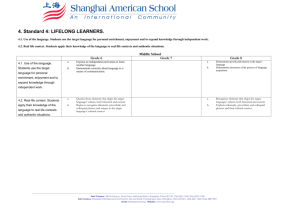Spanish 2B Spring 2014 - Diploma Plus Net / Main Page
advertisement
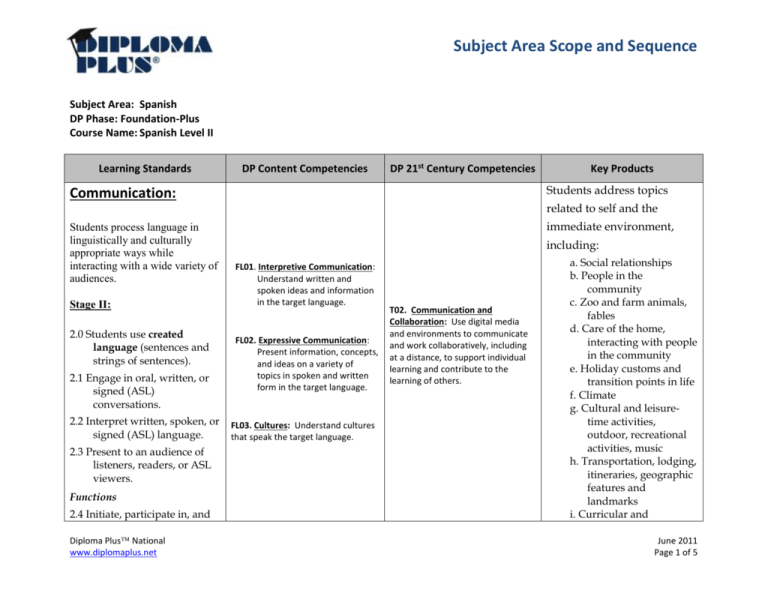
Subject Area Scope and Sequence Subject Area: Spanish DP Phase: Foundation-Plus Course Name: Spanish Level II Learning Standards DP Content Competencies DP 21st Century Competencies Key Products Communication: Students address topics Students process language in linguistically and culturally appropriate ways while interacting with a wide variety of audiences. immediate environment, Stage II: 2.0 Students use created language (sentences and strings of sentences). 2.1 Engage in oral, written, or signed (ASL) conversations. 2.2 Interpret written, spoken, or signed (ASL) language. 2.3 Present to an audience of listeners, readers, or ASL viewers. Functions 2.4 Initiate, participate in, and Diploma Plus National www.diplomaplus.net related to self and the including: FL01. Interpretive Communication: Understand written and spoken ideas and information in the target language. FL02. Expressive Communication: Present information, concepts, and ideas on a variety of topics in spoken and written form in the target language. FL03. Cultures: Understand cultures that speak the target language. T02. Communication and Collaboration: Use digital media and environments to communicate and work collaboratively, including at a distance, to support individual learning and contribute to the learning of others. a. Social relationships b. People in the community c. Zoo and farm animals, fables d. Care of the home, interacting with people in the community e. Holiday customs and transition points in life f. Climate g. Cultural and leisuretime activities, outdoor, recreational activities, music h. Transportation, lodging, itineraries, geographic features and landmarks i. Curricular and June 2011 Page 1 of 5 Subject Area Scope and Sequence close a conversation; ask and answer questions. extracurricular interests and events j. Significant historical figures k. Professions and the working world l. Cuisine and recipes m. Clothing and fashion n. Health, medical care o. Technological advances and innovation 2.5 Demonstrate understanding of the general meaning, key ideas, and some details in authentic texts. 2.6 Produce and present a simple written, oral, or signed (ASL) product in a culturally authentic way. Weekly activities: Partner timed conversations Music listening/writing activity Authentic Assessment: Culture: Diploma Plus National www.diplomaplus.net Mexican Revolution Research project VPA01. Creation: Produce art June 2011 Page 2 of 5 Subject Area Scope and Sequence To understand the connection between language and culture, students discern how a culture views the world. Students comprehend the ideas, attitudes, and values that shape the target culture. Stage II: 2.0 Students choose an appropriate response to a variety of situations. 2.1 Demonstrate understanding of the roles that products, practices, and perspectives play in the culture. 2.2 State similarities and differences in the target cultures and between students’ own cultures. 2.3 State reasons for cultural borrowings. Diploma Plus National www.diplomaplus.net FL03. Cultures: Understand cultures that speak the target language. FL04. Comparisons: Develop insight into the nature of language and culture by comparing primary language and culture with another through individual elaboration, flexibility, fluency, knowledge, experience, originality, and/or personality. VPA02. Aesthetic Capability: Establish and develop aesthetic (artistic) capability VPA03. Appreciation: Analyze work to reveal its critical attributes. Gain insight into their own language and culture Identify some of the social and cultural characteristics of Spanish-speaking countries Authentic Assessment: VPA04. Culture and Style: Formulate stylistic and cultural judgments about a work. FL05. Communities: Participate in communities at home and around the world that speak the target language. VPA05. Vision: Develop a sense of observation, perspective, interpretation, and insight Immigration Project Travel Research Project VPA06. Evaluation: Judge one's own work and working process and the work of others in relation to standards of the field. June 2011 Page 3 of 5 Subject Area Scope and Sequence Structures: As they progress along the Language Learning Continuum, students use linguistically and grammatically appropriate structures to comprehend and produce messages. Students identify similarities and differences among the languages they know. FL01. Interpretive Communication: Understand written and spoken ideas and information in the target language. FL02. Expressive Communication: Present information, concepts, and ideas on a variety of topics in spoken and written form in the target language. E10. Conventions: Apply knowledge of language structure and conventions (grammar, spelling and punctuation). Develop grammar and vocabulary skills through written and oral exercises Stage II: 2.0 Students use sentence-level elements (morphology or syntax or both) to understand concrete and factual topics. 2.1 Use sentence-level elements (morphology or syntax or both) to produce informal communications. 2.2 Identify similarities and differences in the sentencelevel elements (morphology or syntax or both) of the languages the students know. Diploma Plus National www.diplomaplus.net June 2011 Page 4 of 5 Subject Area Scope and Sequence Settings: As students progress along the Language Learning Continuum, they carry out tasks in stage- and age-appropriate situations that reflect the target culture. Stage II: 2.0 Students use language in interpersonal settings. FL05. Communities: Participate in communities at home and around the world that speak the target language. P02. Planning and Responsibility: Demonstrate ability to create and execute effective plan and take responsibility for outcomes. P05. Reflection and Evaluation: Assess current knowledge, progress, and effectiveness of process and actions. Apply information learned to real situations Describe friends and family Participate in conversation and discussions where culture and knowledge are being exercised to expand learning. 2.1 Participate in age-appropriate cultural or language-use opportunities outside the classroom. Diploma Plus National www.diplomaplus.net June 2011 Page 5 of 5
